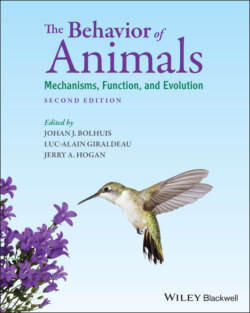Читать книгу The Behavior of Animals - Группа авторов - Страница 46
Toward a features-relating-algorithm as a principle in configurational perceptio n
ОглавлениеHow does prey look to toads? Using dummies, an experimental procedure enables one to measure a toad’s prey-catching activity in response to the visual feature in question and to change it, while other stimulus parameters are held constant. This allows one to evaluate the effect of this change on prey-category formation (Ewert 1974, 1984; see also Further Reading, Movie A2).
Since toads hunt moving objects, it makes sense to change a visual variable related to movement. Figure 2.8A shows that stepwise extending a moving rectangular black stripe against white background parallel to the movement direction raises the prey value within limits, e.g., resembling woodlice, millipedes, or worms (chart p). Extending a stripe crosswise to the movement direction progressively reduces the prey value and signals threat (chart c). Toward squares of different sizes, the influences of both features p and c interact, thus yielding a preferred square of approximately 10 mm edge length, e.g., simulating bugs (chart s). A large moving square of about 100 mm edge length, like a shadow from an airborne predator, elicits escape.
Figure 2.8 Prey-feature analysis in common toads. The configurational paradigm involves three types of moving rectangular black stimuli: stripes extended parallel (p) or crosswise (c) to the movement direction, and squares (s) of different edge lengths. A) Prey-catching activity, RB (mean values, n = 15 toads (Ewert 1984). B) Activity, RN, of prey-selective tectal T5.2 neurons (mean values, n = 18 neurons) in awake toads being pharmacologically immobilized (required for stable neuron recordings through the entire stimulus program within a perimeter device); deg: degrees of visual angle (Wietersheim v. & Ewert 1978; cit. Ewert 1984.).
In reminiscence of the term key-stimulus, the “key” is inherent in an algorithm—calculation method—that enables the toad’s visual system to get access to the configurational prey-category by weighting p and c (Figure 2.8A) according to the equations shown in Table 2.5.
Table 2.5 Constants α and β determining essential traits of the features (p,c)-relating-algorithm; k1 and k2 depending on other stimulus parameters and the toad’s prey-catching motivation. RB = prey-catching orienting activity [responses/30s]. (Ewert 1984).
Variations in other stimulus parameters, e.g., movement direction (Figure 2.4), velocity, motion pattern, or background pattern (cf. Movie A2) influence a toad’s general prey-catching activity, but the basic effects of the configurational features p and c (Figure 2.8A, charts p,c) are invariant to those changes (Burghagen & Ewert 1982, 1983).
Developmental studies showed that the features-relating-algorithm emerges—without prey-catching experience—after metamorphosis with transition from aquatic to terrestrial life (Traud 1983; cit. Ewert 1984). The principle is common to terrestrial anurans but shows species specificities (Burghagen 1979; Ewert & Burghagen 1969; cit. Ewert 1984).
